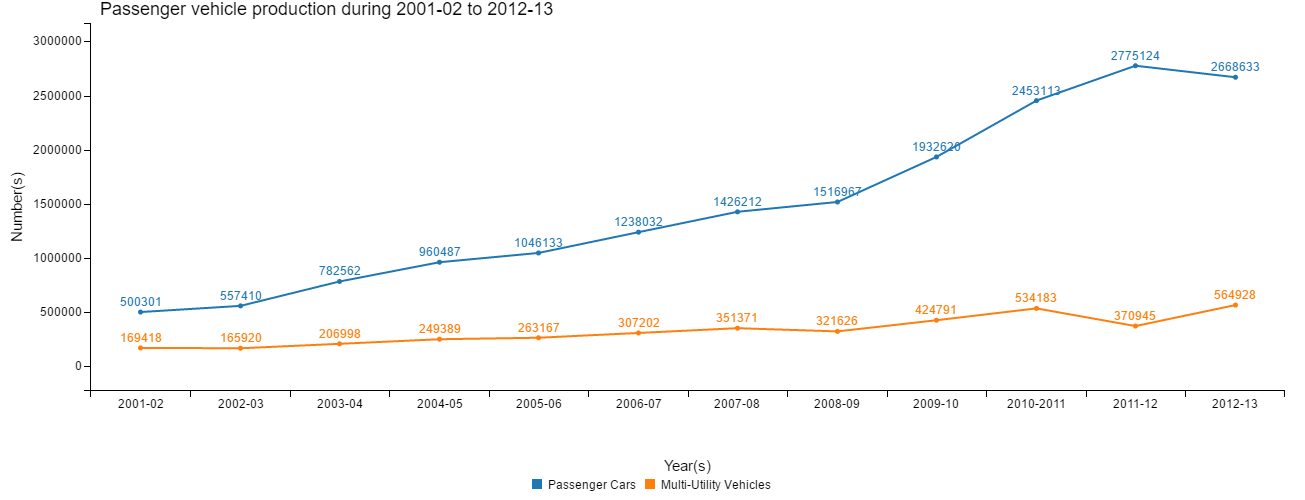 GOVERNMENT
OF INDIA
GOVERNMENT
OF INDIA
 GOVERNMENT
OF INDIA
GOVERNMENT
OF INDIA

Automobile industry is one of the largest industries in India. It is one of the key drivers of the Indian economy. Since the liberalization of the automobile sector in 1991 and allowing of 100 percent FDI through automatic route, Indian automobile sector has come a long way. Today, almost every global auto major has set up facilities in the country. Different types of vehicles are not only being produced in India; but also exported to different countries around the world.
Automobile Production is undertaken in India at a large scale. Different types of vehicles are manufactured in India. The major categories of automobile production are: Passenger Vehicles (PVs), which is bifurcated into two segments viz. Passenger Cars and Multi-Utility Vehicles; Commercial Vehicles (CVs), bifurcated into two segments i.e. Medium & Heavy Commercial Vehicles (M & HCVs) and Light Commercial Vehicles (LCVs); Three Wheelers and Two Wheelers.
The total production of vehicles was 5316302 in 2001-02. It increased to 23366246 in 2014-15, recording an absolute growth of 18049944 vehicles as compared to 2001-02. In percentage terms, the total growth recorded was 339.52% during the period from 2001-02 to 2014-15 i.e. the annual growth of 26.12%. There was growth of 1866081 vehicles (8.68%) in 2014-15 as compared to 2013-14.
In percentage terms, the total growth recorded was 339.52% during the period from 2001-02 to 2014-15 i.e. the annual growth of 26.12%. There was growth of 1866081 vehicles (8.68%) in 2014-15 as compared to 2013-14.
https://data.gov.in/visualize/?inst=652dbeae30d1cecc5fda35a71f482138&vid=13321
The production of Passenger Cars was 500301 in 2001-02. It increased to 2590917 in 2014-15, recording an absolute growth of 2090616 Passenger Cars as compared to 2001-02. In percentage terms, the total growth recorded was 417.87% during the period from 2001-02 to 2014-15 i.e. the annual growth of 32.14%. There was growth of 71636 Passenger Cars (2.84%) in 2014-15 as compared to 2013-14.
The production of Multi-Utility Vehicles was 169418 in 2001-02. It increased to 629255 in 2014-15, recording an absolute growth of 459837 Multi-Utility Vehicles as compared to 2001-02. In percentage terms, the total growth recorded was 271.42% during the period from 2001-02 to 2014-15 i.e. the annual growth of 20.88%. There was growth of 60563 Multi-Utility Vehicles (10.65%) in 2014-15 as compared to 2013-14.
The production of M & HCVs was 96752 in 2001-02. It increased to 268553 in 2014-15, recording an absolute growth of 171801 M & HCVs as compared to 2001-02. In percentage terms, the total growth recorded was 177.57% during the period from 2001-02 to 2014-15 i.e. the annual growth of 13.66%. There was growth of 46997 M & HCVs (21.21%) in 2014-15 as compared to 2013-14.
The production of LCVs was 65756 in 2001-02. It increased to 428530 in 2014-15, recording an absolute growth of 362774 LCVs as compared to 2001-02. In percentage terms, the total growth recorded was 551.7% during the period from 2001-02 to 2014-15 i.e. the annual growth of 42.44%. There was decline of -48949 LCVs (-10.25%) in 2014-15 as compared to 2013-14.
The production of Three Wheelers was 212748 in 2001-02. It increased to 949021 in 2014-15, recording an absolute growth of 736273 Three Wheelers as compared to 2001-02. In percentage terms, the total growth recorded was 346.08% during the period from 2001-02 to 2014-15 i.e. the annual growth of 26.62%. There was growth of 118913 Three Wheelers (14.33%) in 2014-15 as compared to 2013-14.
The production of Two Wheelers was 4271327 in 2001-02. It increased to 18499970 in 2014-15, recording an absolute growth of 14228643 Two Wheelers as compared to 2001-02. In percentage terms, the total growth recorded was 333.12% during the period from 2001-02 to 2014-15 i.e. the annual growth of 25.62%. There was growth of 1616921 Two Wheelers (9.58%) in 2014-15 as compared to 2013-14.
The production of Passenger Vehicles (PVs) including passenger cars and multi-utility vehicles has increased many-fold since  2001-02. Trend of production of Passenger Vehicles (PVs) including passenger cars and multi-utility vehicles from 2001-02 to 2012-13 is shown in visualization:
2001-02. Trend of production of Passenger Vehicles (PVs) including passenger cars and multi-utility vehicles from 2001-02 to 2012-13 is shown in visualization:
https://visualize.data.gov.in/?inst=8b9b6e8b-12bc-4f05-8508-df05e1eb3974&vid=41061
The production of passenger cars in India was 500301 in 2001-02. It increased to 2668633 in 2012-13, registering an absolute growth of 2168332 passenger cars. The production of multi-utility vehicles in India was 169418 in 2001-02. It increased to 564928 in 2012-13, registering an absolute growth of 395510 Multi-Utility Vehicles. Thus, the production of Total Passenger Vehicles (PVs) in India was 669719 in 2001-02. It increased to 3233561 in 2012-13, registering an absolute growth of 2563842 Passenger Vehicles (PVs).
There was a decline in the production of passenger cars in India in 2012-13. But, on the other hand, there was a steep growth in the production of multi-utility vehicles in the same year. This indicates the shift in the customer preference for multi-utility vehicles particularly for sports-utility vehicles (SUVs) instead of the passenger cars.
Air Pollution
On the one hand automobiles are boosting the Indian economy by creating employment opportunities, improvement in productivity as well as facilitating the consumers in travelling and other day-to-day activities.
Many passenger vehicles using petrol are now having diesel versions, which is much more polluting as compared to petrol version. As per some estimates, more than half the cars on the streets are going to be powered by diesel by 2020.
Exposure to air pollution can lead to respiratory and cardiovascular diseases, which is estimated to be the cause for millions of early deaths and the health cost of air pollution has been assessed at a significant percentage of the GDP of the world and that of India. According to the data released by WHO, air pollution was responsible for 3.7 million deaths of people aged under 60 in 2012.
In recent years, air pollution has acquired critical dimensions and the air quality in most Indian cities that monitor outdoor air pollution fail to meet WHO guidelines for safe levels. The levels of PM2.5 and PM10 (Air-borne particles smaller than 2.5 micrometers in diameter and 10 micrometers in diameter) as well as concentration of dangerous carcinogenic substances such as Sulphur Dioxide (SO2) and Nitrogen Dioxide (NO2) have reached alarming proportions in most Indian cities, putting people at additional risk of respiratory diseases and other health problems.
According to World Health Organization (WHO), Delhi tops the list of most polluted cities. Among the world’s 20 most polluted cities in the world, 13 are in India. India is in the group of countries that has the highest particulate matter (PM) levels. Its cities have the highest levels of PM10 and PM2.5 (particles with diameter of 10 microns and 2.5 microns). At the level of more than 150 micrograms, Delhi has the highest level of airborne particulate matter PM2.5, considered most harmful. These figures are six times more than the WHO “safe” limit of 25 micrograms. Uncontrolled vehicular traffic seems to be the primary reason.
Causes for Air Pollution emanating from Automobiles
Some of the reasons for pollution from Automobiles in India are as under:
Emission Standards/ Norms for Automobiles in India
The emission standards/norms for automobiles for the first time were introduced in India in 1991 for petrol and 1992 for diesel vehicles.
In 2002, the Indian government accepted the report submitted by the Mashelkar committee. The committee proposed a road map for the roll out of Euro based emission norms for India. It also recommended a phased implementation of future norms with the regulations being implemented in major cities first and extended to the rest of the country after a few years.
Based on the recommendations of the committee, the National Auto Fuel policy was announced officially in 2003. The roadmap for implementation of the Bharat Stage norms was laid out till 2010. The policy also created guidelines for auto fuels, reduction of pollution from older vehicles and R&D for air quality data creation and health administration.
Bharat stage emission standards are emission standards instituted by the Government of India to regulate the output of air pollutants from motor vehicles. These standards set specifications/limits for the release of air pollutants from equipment using internal combustion engines, including vehicles. The standards, based on European regulations were first introduced in 2000. Progressively stringent norms have been rolled out since then. All new vehicles manufactured after the implementation of the norms have to be compliant with the regulations. Since October 2010, Bharat stage III norms have been enforced across the country. In 13 major cities including Delhi (NCR), Mumbai, Kolkata, Chennai etc., Bharat stage IV emission norms have been in place since April 2010.
The Government plans to promote eco-friendly cars in the country i.e. CNG based vehicle, hybrid vehicle, and electric vehicles. The government has formulated a Scheme for Faster Adoption and Manufacturing of Electric and Hybrid Vehicles in India, under the National Electric Mobility Mission 2020.
The Government of India has planned to implement Bharat stage VI emission norms from the year 2020 to stringently regulate the output of air pollutants from motor vehicles. The Central Government has recently announced that India will leapfrog from the Bharat Stage (BS) IV emission norms currently in force, to the BS VI norms by 2020. Along with vehicle manufacturers, oil companies will also have to prepare to retail BS VI-compliant fuel.
Currently, BS IV fuel is being made available across the country in stages and the entire nation is expected to be covered by April, 2017. BS VI, originally proposed to come in force by 2024 has now been advanced to 2020. While current BS IV-compliant fuel has 50 parts per million (ppm) sulphur; BS VI has a low 10 ppm. Moreover, particulate matter emission for diesel cars and nitrogen oxide levels are expected to be lower. New vehicles to be sold from 2020 onwards will have to be equipped with BS VI compliant engines.
Moreover, the Government plans for a scheme for scrapping old vehicles and help owners of older vehicles, which are more polluting, with a subsidy to upgrade to new vehicles which use cleaner fuel.
Various Measures to be undertaken for Tackling Air Pollution from Automobiles
The emission norms have helped in bringing down the pollution levels in the India. But, it is still too less an impact, as the pollution levels are increasing across India in unprecedented manner, particularly in the metro cities like Delhi.
Therefore, stringent and drastic measures are required immediately like:
References:
https://data.gov.in/catalog/category-wise-automobile-production
http://mospi.nic.in/Mospi_New/upload/SYB2016/ch20.html
http://mospi.nic.in/Mospi_New/upload/SYB2015/ch20.html
http://www.siamindia.com/statistics.aspx?mpgid=8&pgidtrail=9
http://www.siamindia.com/technical-regulation.aspx?mpgid=31&pgidtrail=33
https://en.wikipedia.org/wiki/Bharat_Stage_emission_standards
http://pib.nic.in/newsite/PrintRelease.aspx?relid=136836
http://www.swaniti.com/wp-content/uploads/2015/04/Air-Pollution-in-India.pdf

Comprehensive Analysis of the Mahatma Gandhi Natio...
This infographics on Comprehensive Analysis of the Mahatma Gandhi National Rural Employment Guarantee Act (MGNREGA)
Posted on: October 18th, 2023

First Census of Water Bodies in Haryana...
For the first time in the history of the country, the Ministry of Jal Shakti has conducted the first-ever census of water bodies in India. ...
Posted on: August 31st, 2023